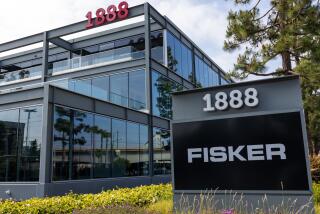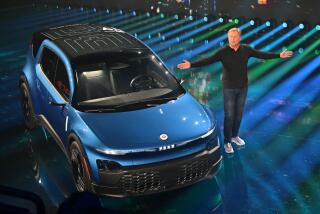Could Saab be saved by Nordic tribalism?
- Share via
Victor Muller wants to do something for his people. You know, tall, blond, Nordic types.
The founder and chief executive of Spyker Cars -- the Dutch manufacturer of spectacular, ultra-exotic sports cars -- was in London last week when he heard the news that a deal to rescue Saab had fallen through. Koenigsegg, another rare-isotope luxury-car maker, had withdrawn its bid to buy Saab from General Motors Co. With no suitors at the door and under intense pressure to transform itself, GM said it would be forced to close and liquidate the 60-year-old car company, based in Trollhatten, Sweden.
Muller and his partner, Russian banking tycoon Vladimir Antonov, quickly put together an offer and forwarded it to Deutsche Bank, which is handling the sale for GM.
“I thought, this cannot be,” the 6-foot-4-inch, fair-haired Muller said Thursday, at the Spyker stand at the L.A. Auto Show. “It’s such a beautiful company.”
And more than that, Muller says, he felt a kind of Nordic tribalism that compelled him to want to rescue Saab. “It’s true, we [the Netherlands and Sweden] are small northern countries. We don’t have big German conglomerates to help us out. I just felt like we have to stand together because we’re the same people, we have the same DNA.”
Whether Muller’s Viking blood alliance will work is anybody’s guess. The obstacles are many.
Saab has been a perennial money loser for GM; the company has said it expects to lose about $434 million this year and about the same next year. In its 10-year history, Spyker too is cash negative. The cars sell for around $300,000, but last year the company built a mere 43 of them. With expensive adventures in the world of Formula One and endurance racing, Spyker has had its own near-death experiences in recent years.
Other issues: Typically such takeover bids are propelled by an opportunity to share technology and amortize investments in tooling (think of Fiat’s synergy-heavy takeover of Chrysler). But Spyker’s sports cars -- hand-built, bejeweled aluminum masterpieces, more like tourbillion chronographs than automobiles -- have almost nothing in common with Saab’s charming but comparatively conventional line of family cars.
Finally, Spyker has no experience in the mine-laden business of global car-building. “Did I say I was going to get rid of all the Saab management?” he said. In other words, a GM-style housecleaning is not in Muller’s plans.
Regardless of the difficulties, Muller seems to think there’s a great value in the Swedishness of the Saab brand. “It’s a lovely brand. It’s so authentic, and that’s such a rare thing.”
To be sure, the Saab brand enjoys an outsize affection among American consumers. Even though GM’s takeover of the company 20 years ago led to better-engineered and more-reliable cars, the old-style Saabs -- with their wild turbo boost, manic torque steer and enormous rear hatches -- are still regarded as superior. Muller himself fondly remembers driving two-stroke Saabs.
“To put them in reverse you used to turn the key and run the engine backward,” he said. “If we fail, I will feel very sorry for Saab.”
The Swedish government has said that it would provide up to $400 million in loan guarantees to help Saab stay afloat, but only if the new buyer committed to keeping production in Sweden.
Muller has no problem with that.
“Absolutely,” he said. “As a matter of principle. The only truly authentic thing about a brand is provenance. The [Porsche] Boxster is built in Finland, OK, no problem. But could they be built in Mumbai? Sure, they’d be 20% cheaper but nobody would buy it.”
On Wednesday, Muller spent an hour at the Saab display studying the 9-5 Aero concept car, the company’s next-generation big sedan, if there is to be one.
“When I see the 9-5, if that is the company’s future, that is a great car. And the 9-4x [a mid-size crossover] and next-generation 9-3 in 2012. That’s a fantastic lineup of product.”
It’s fair to say that Muller was the only one at the Saab booth smiling.
Neil’s picks
Best-looking car: It’s not particularly new and it’s not particularly representative of the production car to come in 2010, but the Volvo S60 Concept -- a copper-skinned beauty with long, graceful roof arches and heroic front styling -- just grabbed me by the lapels. Among the savory details are the twin reflectors in the headlamps that are designed to look like Viking longboats rowing in formation. You don’t see that every day. And the central console that runs from the dash to the back seat is made of a single, beautiful swell of Orrefors crystal, which probably wouldn’t pass crash-test standards at any price.
Like Saab, Volvo retains a strangely indelible residual charisma as a properly Swedish brand, despite being owned by Ford Motor Co. Ford has been hosting troupes of potential investors from China in Gothenburg, but according to one Volvo insider, the language barrier (Swedish-English-Mandarin) has been so formidable that people are “completely mystified.”
Why bankruptcy is a good thing: Imminent disaster does seem to focus the mind. During a show where GM’s front-office drama was all the buzz, the company unveiled some pretty serious product, including the 2011 Buick Regal, a lightly Americanized version of the mid-size Opel Insignia. Taut, tailored, substantial and unforced, the Regal is a handsome car with an interior to match. The car will be powered by a 2.4-liter four-cylinder paired with a six-speed automatic, good for 30 mpg; later, a turbocharged 2.0-liter, 220-hp four will power a sportier version.
Meanwhile, Cadillac unveiled the devastating CTS Coupe, a glowering, predatory mega-coupe that looks like it was drawn by Frank Miller after his happy meds ran out. And not 50 feet away was the Cadillac Converj, a Volt-based concept for a luxury coupe. The Converj also scores a clean kill in the looks department, particularly when you compare it with other car companies’ green-car concepts, such as the Honda P-NUT, which looks like it’s double-parked at a UFO convention in Roswell, N.M.
Biggest sign of the changing world order: Not too long ago, Suzuki couldn’t get arrested if it were carrying a bloody ax down the street. But in the last year or so -- buoyed by the success of the SX4 -- the company has been coming on. This week it announced its Test Drive Challenge, which dares consumers to compare the new Suzuki Kizashi -- on the turnstile at the L.A. Auto Show -- with no less than the Audi A4 and Acura TSX. If shoppers ultimately decide to buy the Audi or the Acura, Suzuki will give them $100. For the few C-notes it will cost Suzuki, this is a great promotion, if only to get Suzuki mentioned in the same breath with Acura and Audi.
Car I’d most like to drive: The Audi e-Tron coupe, which I saw a few months ago at the Frankfurt Auto Show, is a highly speculative electric sports car from the German giant (part of VW Group). The car reappeared at the L.A. show painted a heart-attack metallic umber. The e-Tron is powered by four electric motors (one for each wheel) generating together 3,319 pound-feet of torque. With a half-ton of liquid-cooled batteries and a range of 150 miles, the electron-killing e-Tron is nobody’s idea of an eco-friendly grocery getter. But I bet it’s more fun than nitrous oxide.






